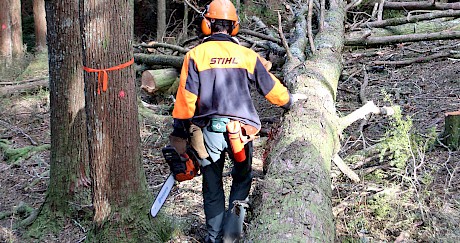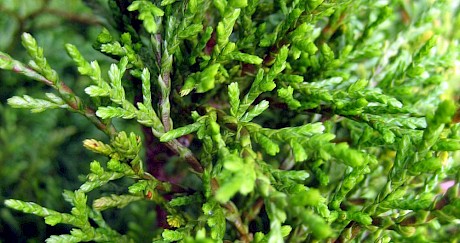Pukatea (Laurelia novae-zelandiae)
Introduction
Pukatea is a member of the sub-tropical family Atherospermataceae, the southern sassafrases, although it had for a long time been placed in Monimiaceae. The family is mostly confined to Australia. Pukatea is the only New Zealand species in this family.
History
The Maori used pukatea for several medicinal purposes, it containing an alkaloid related to morphine although without the side effects of that drug. Because of these analgesic properties the pulped inner bark was used to relieve toothache and a decoction of bark boiled in water was used for ulcers, skin complaints generally and syphilis. The bark and dried leaves have proven poisonous to sheep and rats so care must be taken if pukatea is to be used medicinally. Because the timber is very light, pukatea logs were used for river canoes although they easily became waterlogged. It was also used for carving, particularly canoe figureheads. Early European uses were for boat building, weatherboards, motor body building and, because it is resistant to marine borer, for wharf piles. Although about 225 m³ annually was milled in the early 1950s, scarcity has reduced its usage to almost zero over the past 50 years.
Distribution
Pukatea grows throughout the North Island, at the very north tip of the South Island (Lat. 42°) and extends down the West Coast to 46°. It is most abundant in the western areas of central North Island. The species grows in association with kahikatea, rimu, miro, tawa, northern rata, towai, taraire, kohekohe and totara. It grows up to 600 metres in the North but only to 200 metres in the South Island. Pukatea is most common on deep fertile alluvial soils and can grow in semi-swamp; it is also quite common in damp, shaded gullies and grows on a wide range of damp soils including limestone.
Tree size and growth
Allan records pukatea growing to 35 metres tall and up to 200 cm diameter. However the pukatea recorded by Burstall and Sale are smaller than Allan’s maximum and in most forests seldom seem to grow more than 1 metre in diameter. Growth data for planted trees is limited with mean annual height growth rate ranging from 0.3 to 0.6 metres and diameter annual increment of between 0.4 and 0.9 cm. Data from the latest survey of planted trees is expected to provide more information.
Buttress roots
Pukatea is characterized by having large plank-like buttresses, up to two metres high, at the base of mature trees. This feature is common in tropical trees, to which general group pukatea belongs, and has evolved as a support for trees growing in wet conditions. Large pukatea are easily identified by this trait.
Timber
Timber characteristics, with P radiata figures shown in brackets for comparison, are as follows: -
Density: 465 kg/ m³ (500 kg/m³)
Moisture content: green heart 156% (130%)
Tangential shrinkage -green to 12% m.c 6.5 % (4.7%)
Radial shrinkage 2.2% (2.2%)
Modulus of rupture 89 Mpa (90 Mpa)
Modulus of elasticity 11 Gpa (9 Gpa)
The heartwood is an even, dull grey-brown colour, sometimes with a green tinge or green streaks and the sapwood is brownish-white. The wood, being light, is more like a softwood than a hardwood and is relatively easily dried.
Fruit
The fruit of pukatea is wind dispersed and the species regenerates profusely close to seed trees and under moderate shade.
Potential
This is a species which should be more closely investigated. It is an easily worked, stable and light timber and, although not naturally durable, is relatively tough and resistant to marine borer. Although it appears to grow slowly there is some indication that juvenile growth is quite rapid and that faster growth may be obtained by improving establishment and management practices. A potentially fast growth rate and lack of damaging agencies, together with the straight and tall natural form of the tree, indicates it could be one of the more useful of our hardwood species.
Research requirements
Establishment trials on suitable sites should be established to determine whether the indicative growth rate of 1 cm diameter annually can be improved. More studies of the ecology of the species are also warranted, as is deeper investigation of its timber qualities. The potential of chemical by-products from the bark also requires more study.
References
- Allan H H. 1961. Flora of New Zealand Vol. 1 Government Printer Wellington
- Brooker S G, Cambie R C & Cooper R C 1981. New Zealand Medicinal Plants. Heinmann
- Brooker S G, Cambie R C & Cooper R C 1988. Economic native plants of NewZealand. Botany Division D.S.I.R
- Burstal S W & Sale E V 1984. Great Trees of New Zealand
- Clifton N C 1990. New Zealand timbers GP Publications
- Connor HE & Adams N M 1951. The poisonous plants in New Zealand. DSIR
- Dawson J, Lucas R & Connor J 2011. New Zealand’s Native Trees Craig Potton Publishing
- Hinds H V & Reid J S 1957. Forest Trees and Timbers of New Zealand. Govt Printer. Wellington
- Pardy G F, Bergin D O & Kimberley M 1992. Survey of Native tree plantations. FRI Bulletin 175
- Wardle J 2011. Wardle’s Native trees of New Zealand and their story NZ FFA
Species profile by Ian Barton


